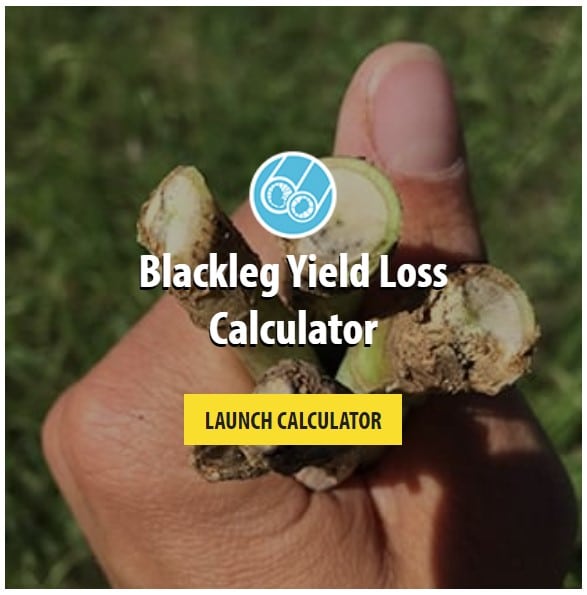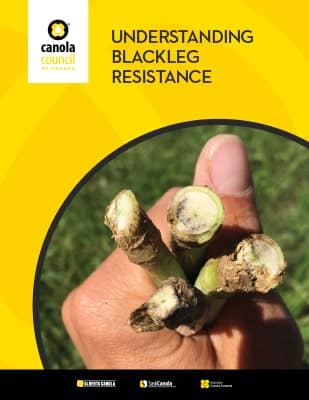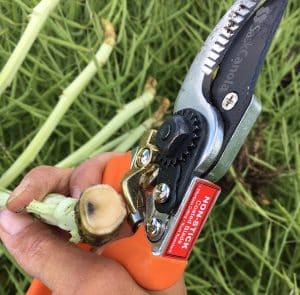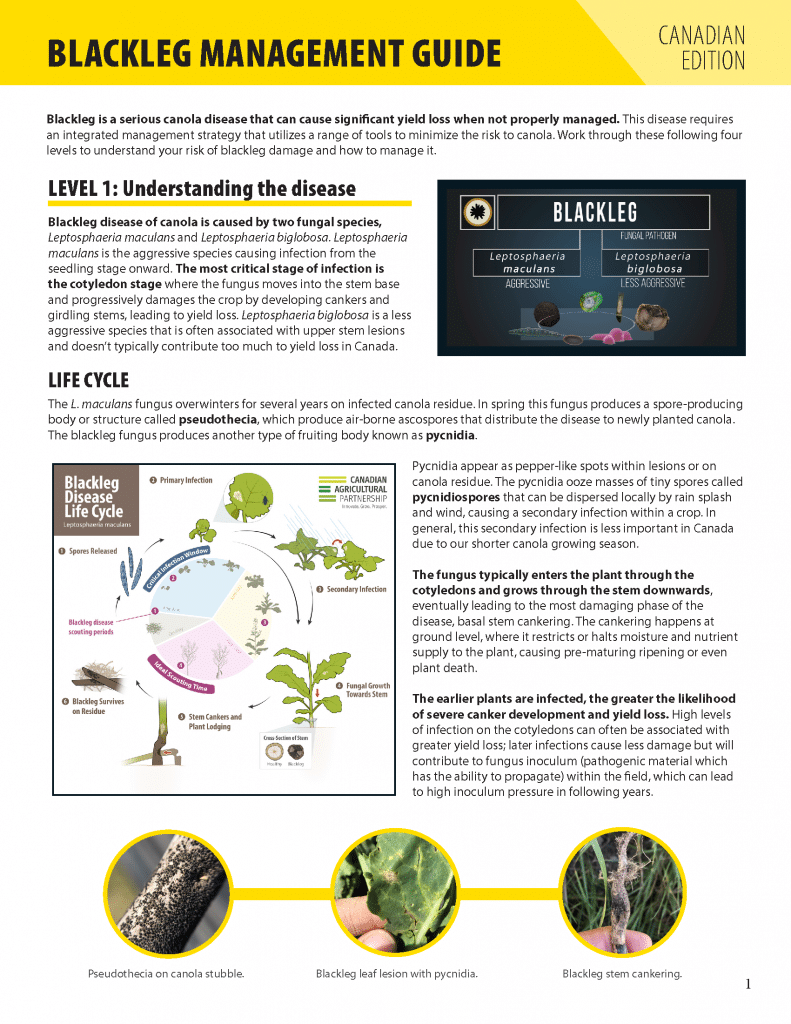Blackleg disease, caused by the pathogen Leptosphaeria maculans, is common in canola across the Prairies. It can cause very high yield loss in cultivars susceptible to the predominant blackleg races in a field. While high yield loss is rare on the Prairies, mostly because farms grow resistant cultivars, blackleg levels are increasing due to shifts in blackleg races and tighter canola rotations. Canola growers can keep blackleg levels low with the following management steps. The final point is on foliar fungicide application.

The 6 basics
Scout
Check canola stems before or during harvest to assess blackleg infection levels. Use the blackleg calculator to assess yield and economic loss associated with blackleg. If economic loss exceeds an acceptable level, move to the next steps. This guide has scouting tips.
Test for blackleg races
Various labs will test stem pieces for blackleg and can provide analysis of blackleg races present. These results will help growers choose the best canola R-genes to use the next time canola goes on that field.
Choose resistant cultivars
This is the most effective management step. Genetic resistance is the reason blackleg is, for the most part, well managed in Canada. When blackleg pathogen levels increase and race populations shift within a field, growers have the option to choose cultivars with resistance to the specific blackleg races in a field. List of cultivars with R-genes identified. Watch the how-to video at the bottom of this article.
In some cases, cultivars with an “R” rating may not have major gene resistance that matches the blackleg races in a field. Stubble tests can indicate the races present.

Extend the break between canola crops
A break of two or more years between canola crops on the same field will give most blackleg resting spores time to degrade, greatly reducing the risk. When canola is grown back to back or with a one year break, blackleg risk escalates considerably. In tight rotations, scouting is essential and it becomes more important to use cultivars with genetic resistance to the most common blackleg races in a field. Seed treatment will also reduce the risk.
Use enhanced seed treatment
Recent research shows that early infection results in higher disease incidence and severity at canola maturity. Certain advanced seed treatments can protect seedlings from early infection. See Table 1 here for seed treatments that work on blackleg. Ask your seed provider which seed treatments they recommend. Agriculture and Agri-Food Canada research shows that seed treatment provides an economic benefit only when used on susceptible cultivars. Resistant cultivars see no benefit from seed treatment because their blackleg severity levels are very low.
Apply foliar fungicide
The basics
For blackleg fungicide to be profitable, you need all three parts of the disease triangle – host, pathogen and environment. Host is a partially resistant or susceptible cultivar. Pathogen is one- to two-year-old stubble with blackleg pycnidia or pseudothecia in the same field or neighbouring field. Environment is moisture along with rain splash/mist and wind to move the spores.
With all three parts of the disease triangle, use Group 11 products with high water volume for coverage, and apply as early as possible. You can tank mix with herbicides as early timing is an advantage for both blackleg and weeds.
The details
Early infection leads to more severe blackleg, and fungicide needs to be applied before infection. Western Canadian research showed that fungicide could reduce disease severity enough to provide benefit in this scenario: Group 11 fungicide applied to a blackleg-susceptible cultivar at the 2- to 4-leaf stage. (The study compared two treatment times: 2- to 4-leaf and bolting. Work from the same researcher showed that infection can occur earlier.) See Table 2 here for foliar fungicides registered for blackleg.
Early-season fungicide to prevent blackleg can provide a return on investment in a field with all of the following:
- Canola is in a tight rotation.
- The canola seed lot does not have enhanced seed treatment.
- Blackleg was present in the previous canola crop and infected stubble is found in the same field or in a neighbouring field. If the field was not scouted but the area has a history of blackleg, you could assume blackleg is present. This covers the pathogen part of the disease triangle.
- The cultivar is susceptible to blackleg races in the field. Wounds from hail or insect feeding can increase the risk of infection. This covers the host part of the disease triangle.
- Moist weather with wind, mist and rain splash can increase the spread of blackleg spores from stubble to living tissue. Fungal growth also tends to be more active in moist conditions. This covers the environment part of the disease triangle.
Fungicides can be tank mixed with herbicide – both of which tend to provide greater economic benefit when applied early. Follow label instructions for tank mixes.
Verticillium stripe bonus. Researchers have shown a connection between blackleg and verticillium stripe infection. Often both diseases are found together in a plant. One way to reduce verticillium risk may be with a strong blackleg resistant cultivar, but this hypothesis has not yet been tested.


